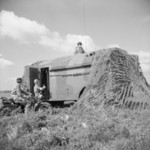AEC Armoured Command Vehicle
| Country | United Kingdom |
| Manufacturer | Associated Equipment Company |
| Primary Role | Armored Car |
Contributor: Alan Chanter
ww2dbaseDeveloped to replace the small number of Guy Lizard and Morris Armoured Command Vehicles tyhat had been available to the British Army at the start of World War Two, the 12-ton AEC Armoured Command Vehicle was introduced during 1941. The chassis from the AEC Matador prime mover was employed for this vehicle, which was initially designated as the Lorry, 3 ton, 4x4 Armoured Command AEC, but was more commonly known to the troops as "The Dorchester", named after a luxury hotel in London. For the Dorchester there were some modifications to the Matador's chassis - the winch and air cylinder and fuel tank were removed and a new rectangular fuel tank fitted in the space previously occupied by the air cylinder. Weighing nearly 12 tons, the AEC was powered by an AEC diesel engine of 95 brake horsepower which gave it a top speed of 35 miles per hour. No armament was fitted although a Bren light machine-gun was usually carried for local defence.
ww2dbaseThe armoured bodywork was fitted out internally for command purposes and carried two radio sets - a No. 19 high power set for longer range communications and a low power set for liaising with other vehicles. The Mark II variant (in a low power version only) differed in having an internal partition that divided it into a front compartment for staff officers and the rear for the wireless equipment. The vehicle carried an eight man crew (three officers, three radio operators and two drivers).
ww2dbaseThe AEC Armoured Command Vehicles were first used in action in the North Africa campaign, where incidentally, three were captured and used by German generals, two of them by Erwin Rommel and his staff. These two vehicles were nicknamed "Max" and "Moritz", although the type was given the generic name of Mammut (English: Mammoth) by the Germans.
ww2dbaseThe Armoured Command Vehicles were large and conspicuous and, of course valuable targets as they carried senior officers, so Major Jasper Maskelyne (a well-known stage magician in civilian life) who commanded a camouflage unit in the Royal Engineers, was asked to design a special camouflage for them. What he did was to disguise them as the ordinary Matador gun tractors which were in wide usage in the British Army. This involved black shadow painting on various parts of the hull, the addition of a canvas cover to the top surfaces and an extension to the armoured nose-plate.
ww2dbaseA total of 416 AEC AEC Armoured Command Vehicles were built, and these were supplemented in 1944-45 by 151 larger vehicles on an AEC 6-wheel drive chassis. This was very much roomier than its predecessor, being 6 feet longer and slightly lower. It was also very much heavier at 19 tons loaded, and was powered by a more powerful AEC 135 brake horsepower diesel engine. Two versions were again produced. The first having one No. 19 high power wireless set and one No. 19 low power wireless set and the other with one No. 53 set and one No. 19 set.
ww2dbaseSources:
B. T. White: Tanks and Other Fighting Vehicles 1942-45 (Blandford Press, 1975)
Bruce Quarrie: Afrika Korps (Patrick Stephens Ltd, 1975)
Wikipedia
Last Major Revision: Aug 2022
SPECIFICATIONS
AEC Armoured Command Vehicle
| Machinery | AEC 187 6cyl diesel engine rated at 95bhp |
| Suspension | Wheeled 4x4 independent coil springs |
| Armor | 12mm |
| Crew | 8 |
| Length | 6.10 m |
| Width | 2.36 m |
| Height | 2.90 m |
| Weight | 12.4 t |
| Speed | 60 km/h |
| Range | 450 km |
Photographs
 |  |
Please consider supporting us on Patreon. Even $1 per month will go a long way! Thank you. Please help us spread the word: Stay updated with WW2DB: |

- » Wreck of Teruzuki Found (27 Jul 2025)
- » USS Orlean's Bow Found (22 Jul 2025)
- » The Emperor of Japan Planned to Honor WW2-era Japanese POWs in Mongolia (4 Jul 2025)
- » US State Lawmaker John Winter Caught Using Racial Slur "Jap" and Apologized (11 Jun 2025)
- » US Government Plans to Purge WW2 Information (17 Mar 2025)
- » See all news
 |  |
- » 1,182 biographies
- » 337 events
- » 45,119 timeline entries
- » 1,248 ships
- » 350 aircraft models
- » 207 vehicle models
- » 376 weapon models
- » 123 historical documents
- » 261 facilities
- » 470 book reviews
- » 28,409 photos
- » 365 maps
Winston Churchill, 1935